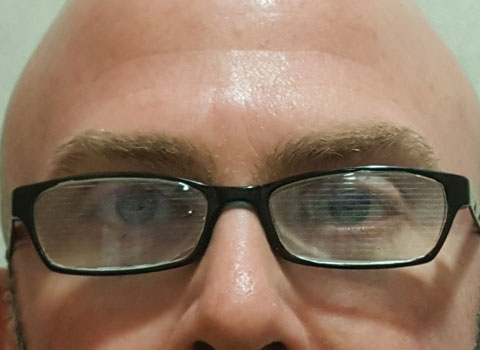 |
| A longer prism adaptation period is not necessary for successful patient outcomes post-surgery. Photo: Marc Taub, OD, and Paul Harris, OD |
The benefits of preoperative prism adaptation tests (PATs), involving wear of Fresnel prisms or prism glasses, for esophoria patients undergoing correction surgery are far from controversial; it is known that prism adaptation may increase the angle of deviation (AOD) and that preoperative PATs can determine the maximum adapted angle and amount of muscle relocation, improving the lasting outcomes of surgery and motor and sensory function.
However, the recommended duration of prism adaptation is not something that all studies or doctors have agreed on. In Austria, some eye care professionals firmly believe prism glasses must be worn for weeks to years to ensure surgical success, but is such lengthy preoperative protocol actually necessary? After investigating this question, researchers recently concluded that PAT duration remains independent of AOD increase, meaning prolonged prism adaptation holds no advantage in terms of better patient outcomes.
The 116 study participants came from five eye departments in Austria and were observed from 2012 to 2019. They each received a motor function assessment and orthoptic exam and then were divided into three groups:
- Group 1: participants who had a short adaptation period of one to five hours
- Group 2: participants who had received partial correction of their esodeviation
- Group 3: participants who underwent full prismatic correction for their esodeviation
Groups 2 and 3 wore prism glasses for at least four weeks and underwent PAT to determine the maximum angle within a week before surgery.
There were no significant differences in motoric or sensoric success rates between the groups at any point after surgery. Within three months, 97% of patients had motor fusion, which was down to 89% by the one-year mark.
“Linear regression analysis revealed a significant increase in AOD with PAT irrespective of the duration of prism adaptation,” the researchers noted. “This finding is in alignment with a study by Altman et al. (1999), which showed that a 24-hour prism adaptation duration was sufficient in order to reach maximum angle. Ela-Dalman et al. (2006) [also] showed in a study with 29 participants with acquired esotropia that the maximum AOD can be reached after PAT within one hour.”
Since the evidence suggests longer durations of prism adaptation aren’t linked to better surgical outcomes or motoric or sensory function, the researchers recommend keeping PAT durations short to prevent the patient from spending needless time and money or enduring unnecessary discomfort and inconvenience. “Considering side effects of Fresnel prisms such as yellow sight, peel of the prims after about three months in place, reduction of visual acuity about one line per five prisms and related impact on quality of life, we conclude that a prolonged PAT is not in the patient’s best interest,” the study authors noted.
Pichler U, Schmidbauer E, Hermann P, et al. A comparative study of various prism adaptation forms in the surgical management of esophoria. Acta Ophthalmol. August 24, 2021. [Epub ahead of print]. |


